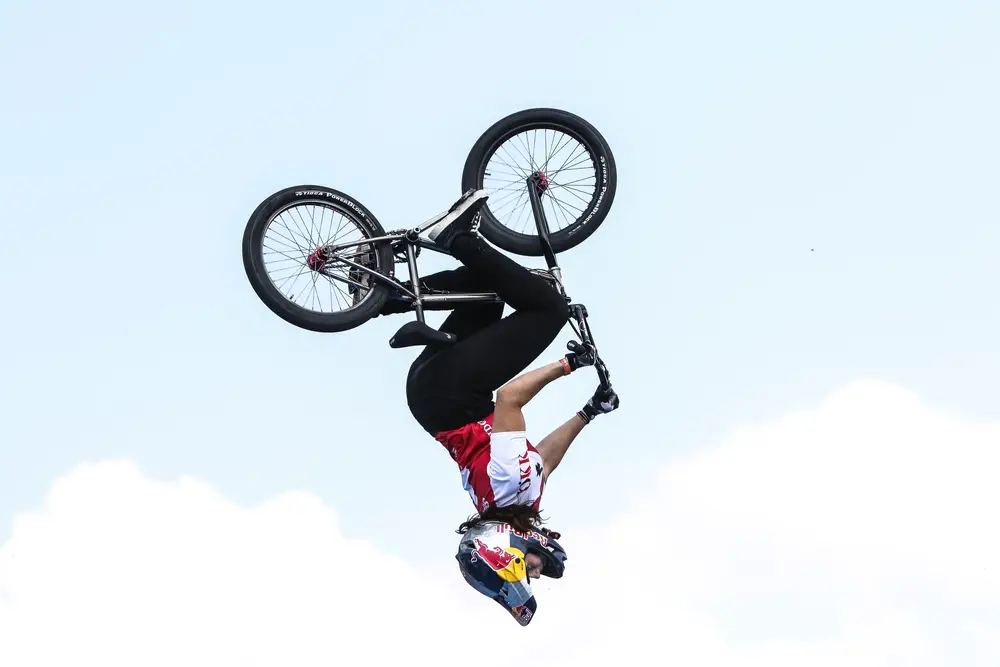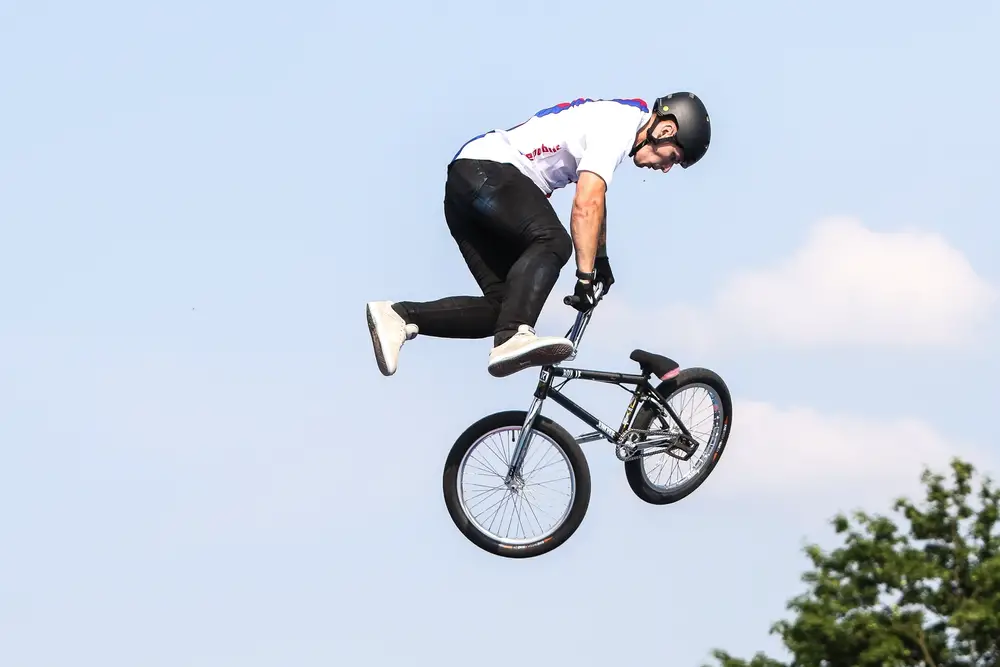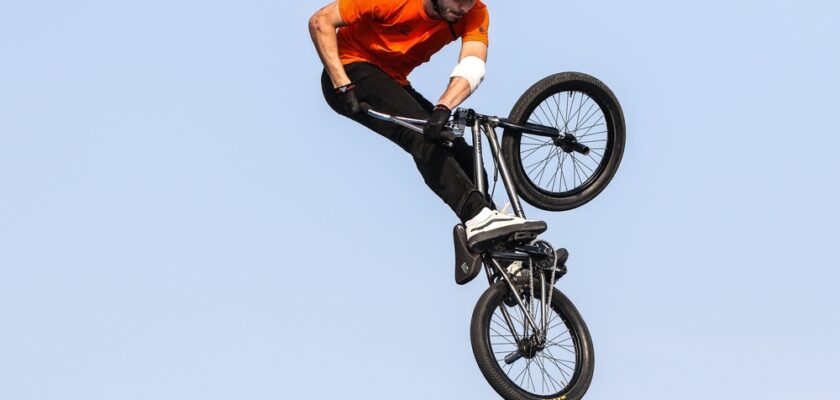BMX Freestyle is a type of cycling that consists of the best acrobatic and radical maneuvers. The sport was born in the 1970s and soon became very popular all over the world.
Soon, BMX Freestyle, a sport of high impact and intense competition, stood out for its electrifying and breathtaking competitions. It can be practiced in parks, ramps and other structures specially designed for the sport.
To ensure fairness and the safety of participants, there are clear and strict rules in the sport. With this in mind, we’ve brought you this material with the rules of BMX Freestyle for you to get to know.
Check it out!
Open your Betano account and get up to 1,000 reais in bonuses.
PIX payments, live games and super odds!
Click here to open your account!

BMX Freestyle rules: complete list
- Venue and structures;
- Competition;
- Scoring;
- Participants;
- Equipment;
- Safety
- Infringements;
- Procedures.
BMX Freestyle rules: venue and structures
BMX Freestyle venues are basically parks and ramps. They are carefully designed to enhance the athletes’ performance and safety during maneuvers.
The dimensions and structures vary according to the type of BMX Freestyle, here are the main ones:
- Park: consists of a combination of ramps, bowls and obstacles. The dimensions can vary, but generally include a wide area with different heights and slopes to allow for a variety of maneuvers.
- Street: Inspired by urban environments, the street circuit features handrails, stairs, benches and other elements found on the streets. The structure is more horizontal and less vertical.
- Vert: is a large vertical ramp (half-pipe), with walls that reach more than 4 meters high. The width of the half-pipe is also significant to allow for various maneuvers.
BMX Freestyle rules: competition
The duration of BMX Freestyle competitions can vary depending on the format of the event and the number of participants.
However, it’s important to know that each athlete has a limited amount of time to perform their maneuvers, which can vary from 1 to 3 minutes per round.
In more structured competitions, such as world championships or the Olympic Games, the event is divided into several rounds. See:
- Qualifiers: is the round in which all participants compete to qualify for the next phase.
- Semifinals: are made up of the best qualifiers from the knockout rounds, who then compete again.
- Finals: the top finishers then compete for the podium.
BMX Freestyle rules: scoring
Now let’s talk about scoring in BMX Freestyle. This is determined by a panel of judges who evaluate the performances based on various criteria.
The main evaluation factors considered are as follows:
- Difficulty of maneuvers: the more complex and risky maneuvers tend to receive higher scores.
- Execution: evaluates the precision and smoothness with which the maneuvers are performed.
- Creativity: analyzes the originality of the maneuvers and the way in which the athlete uses the track.
- Fluidity: is the rider’s ability to maintain a constant flow of maneuvers without interruptions or falls.
- Variety: the diversity of the maneuvers performed during the performance is very important.
The judges assign a score that generally ranges from 0 to 100, and the average of these scores is used to determine the athlete’s ranking.
BMX Freestyle rules: participants
The number of participants in a BMX Freestyle competition can vary greatly, ranging from local competitions with just a few riders to world championships with dozens of participants.
Each event can set a maximum number of competitors, thus ensuring that the tournament is viable and very safe. Here’s what often happens at big events like these:
- Qualifiers with a large number of participants;
- A reduction in the number of people in the semi-finals;
- A limited number of finalists, usually between eight and 12 riders reach the final.
BMX Freestyle rules: equipment
To compete in BMX Freestyle safely, athletes must use specific equipment that is mandatory. Here are the main ones:
- Helmet: the helmet must be certified for use in extreme sports, and must cover the athlete’s entire head
- Knee and elbow protectors: these are crucial to protect against falls and serious impacts.
- BMX bike: The bike is the main item, of course, and should be in good condition, with all components working properly. Efficient brakes are recommended, although some models don’t have this function.
In addition to the items mentioned above, the use of other protective equipment, such as gloves and mouthguards, is recommended to increase safety.
BMX Freestyle rules: safety
Still talking about safety, which is a top priority in BMX Freestyle competitions, there are other measures to be applied. Check them out:
- Track inspection: before each competition, the track is inspected to ensure that it is in suitable condition for the sport.
- Medical presence: first aid teams and doctors are always present to respond quickly to any accidents that may occur, whether serious or not.
- Training and warm-up: training and warm-up sessions are held before the competition, so athletes can familiarize themselves with the track and reduce the risk of injury.
BMX Freestyle rules: infractions
Infractions in BMX Freestyle competitions can result in penalties that affect the athlete’s score or even disqualification. So you need to keep an eye on the rules.
The main infractions are:
- Use of inadequate equipment: if the competitor does not use the mandatory equipment, immediate disqualification may occur.
- Illegal maneuvers: the act of performing maneuvers that endanger the safety of other competitors or the public is prohibited and affects the athlete’s performance.
- Unsportsmanlike conduct: aggression, whether verbal or physical, against other competitors, judges or members of the organization is strictly prohibited.
- Interference: intentionally blocking another competitor’s route can result in the loss of points or disqualification of the athlete.
BMX Freestyle rules: procedures
The competition procedures in BMX Freestyle have been created to guarantee organization and fairness. Here’s how it happens:
- Registration: BMX Freestyle competitors must register in advance, providing personal information and proving the use of appropriate equipment at the time of the competitions.
- Briefing: then, before the competition begins, all participants go through a briefing where the rules and format of the event are reviewed. Extreme attention to the rules is required.
- Running order: the running order of the competitors is usually determined by drawing lots or a preliminary round.
- Judges’ feedback: after each round, the judges provide feedback to the competitors, highlighting strengths and areas for improvement.

BMX Freestyle rules: complete list
- Venue and structures;
- Competition;
- Scoring;
- Participants;
- Equipment;
- Safety
- Infringements;
- Procedures.
Those were the rules of BMX Freestyle! If you liked the content, keep browsing the site for more news, lists, glossaries, specials and much more about the world of sports!



